 Utiliser la réalité augmentée pour révolutionner la technologie de projection, c’est le défi relevé avec brio par Lightform, une start-up californienne. La marque est en effet parvenue à développer un outil qui permet de réaliser des projections sur n’importe quel type de surface. Les utilisateurs n’ont plus besoin d’une surface parfaitement plane pour pouvoir diffuser […]
Utiliser la réalité augmentée pour révolutionner la technologie de projection, c’est le défi relevé avec brio par Lightform, une start-up californienne. La marque est en effet parvenue à développer un outil qui permet de réaliser des projections sur n’importe quel type de surface. Les utilisateurs n’ont plus besoin d’une surface parfaitement plane pour pouvoir diffuser […]
Jean-Philippe Encausse
Shared posts
Lightform : la réalité augmentée au service de la projection
 Utiliser la réalité augmentée pour révolutionner la technologie de projection, c’est le défi relevé avec brio par Lightform, une start-up californienne. La marque est en effet parvenue à développer un outil qui permet de réaliser des projections sur n’importe quel type de surface. Les utilisateurs n’ont plus besoin d’une surface parfaitement plane pour pouvoir diffuser […]
Utiliser la réalité augmentée pour révolutionner la technologie de projection, c’est le défi relevé avec brio par Lightform, une start-up californienne. La marque est en effet parvenue à développer un outil qui permet de réaliser des projections sur n’importe quel type de surface. Les utilisateurs n’ont plus besoin d’une surface parfaitement plane pour pouvoir diffuser […]
Russian Humanoid Robot Firing Guns With Both Hands
This is a video of Russian humanoid robot F.E.D.O.R. (Final Experimental Demonstration Object Research) blasting away with two handguns. But don't worry, guys, this totally isn't a Terminator. "The robot of the F.E.D.O.R. platform showed skills of firing using both arms. Currently the work on fine motor skills and decision algorithms is underway," [Deputy Prime Minister Dmitry] Rogozin wrote on his Twitter. âAccording to Rogozin, training to shoot is a way of teaching the robot to instantaneously prioritize targets and make decisions. "We are not creating a terminator but artificial intelligence which will have a great practical importance in various fields," he added...(Read...)
Go back in time with the Internet Archive’s collection of Macintosh programs from the 1980s

The Internet Archive is an indispensable resource for web users, backing up websites and documents, but also providing copies of historical software, such as the earliest home console and arcade games. Now, there’s a new collection that should delight anyone who grew up in the 1980s: an entire collection of Macintosh programs, which you can play right in your browser.
Earlier today, the site released a new software library: emulated programs from Macintosh computers dating from 1984 through 1989. The collection is a wonderful dose of nostalgia for anyone who grew up using these computers at home, work, or school. The best part is that you can emulate the programs right in your browser.
The collection is pretty remarkable...
GeoCV Raises $1.8 Million For 3D Capture Tech
Google adds WebVR support to Cardboard and Chrome, and debuts WebVR Experiments
Google announced that it's working even harder to bring VR to entry-level price points, by adding WebVR support to Google Cardboard and launching its WebVR Experiments showcase for anyone to access and experience VR.
The post Google adds WebVR support to Cardboard and Chrome, and debuts WebVR Experiments appeared first on Digital Trends.
A Berlin, des mini-maisons pour 100 euros par mois
Gentrification oblige, Berlin est une ville dans laquelle les loyers sont de plus en plus élevés. Pour dénoncer le phénomène, l’architecte Van Bo Le-Mentzel du collectif berlinois Tinyhouse propose des mini-maisons à louer contre cent euros par mois. Dans ces 6,4 m2 et 3,60 mètres de hauteur sous plafond, tiennent une kitchenette, un poêle à bois, un lit, un bureau, un canapé et des toilettes.
Vingt de ces micro maisons ont déjà été installées dans les jardins du Bahaus Archiv, le musée berlinois. L’idée derrière est évidemment très politique. Les membres du collectif défendent l’idée que tout le monde devrait avoir le droit de vivre en ville. Tinyhouse compte pousser le projet plus loin en développant d’ici 2019 un complexe résidentiel de mini-maisons. A quand un tel projet à Paris?




Par Margaux Couturier.
The Future of Augmented Reality Is Bright
Augmented reality is about to change everything.
The post The Future of Augmented Reality Is Bright appeared first on Futurism.
These Might Be the Most Realistic Virtual Objects Ever
Get close and personal with virtual objects.
The post These Might Be the Most Realistic Virtual Objects Ever appeared first on Futurism.
Heineken crée un panneau publicitaire qui défie les passants
En Australie, Heineken met les passants au défi avec un affichage publicitaire qui leur propose de gagner des places de formule 1.
Jusqu’où iriez-vous pour assouvir votre passion ? En Australie, la célèbre marque de bière Heineken propose une expérience surprenante aux amateurs de formule 1. La marque a eu l’idée d’installer un panneau publicitaire qui interagit avec les passants.
Une jeune femme, diffusée en temps réel sur le panneau-vidéo, communique avec les passants et leur propose de gagner des places pour le Grand Prix Rolex d’Australie. Mais en échange, ils vont devoir remporter des défis. Une idée amusante et originale qui témoigne de la volonté de Heineken de surprendre ses consommateurs et de leur offrir une vraie expérience inoubliable.






Source Heineken
Via adeevee.com
Cet article Heineken crée un panneau publicitaire qui défie les passants provient du blog Creapills, le média référence des idées créatives et de l'innovation marketing.
A Compilation of Insane Urban Climbing Stunts
This video puts together a collection of some of the craziest urban climbing stunts from death-defying daredevils Jumping Buddah, Roof Runnerz, Oleg Cricket, Ivan Kiral, Sergey Tracer, and James Kingston...(Read...)
7 Things You Know in UX That Will Help You Design Chatbots

At BEEVA we have been working with chatbots for some time now. In addition to the design framework I previously published, I’m going to share seven things that I brought from my UX design background that helped me approach the chatbots universe.
Visibility of System Status
It’s the first heuristic from Jakob Nielsen and one of the first you will find in every usability checklist. Applied to the chatbot interaction, it’s a must to have a kickass welcome message that sets user expectations and makes it clear which functionalities the chatbot will cover. It may seem obvious that chatbots only cover a small scope, but if you don’t make the scope clear, users will crash with everything your chatbot is not able to meet their expectations.
In addition to the welcome message, we need to remind users where they are and what they are doing. Users that are not paying attention to our chatbot can get lost many times on a single conversation.

Personality
It’s a concept commonly underrated on interfaces, but it’s one of the fundamental basis of chatbots. It was perfectly studied on Designing for emotion, and the best example ever designed is the personality crafted for Mailchimp (here).
Because the interaction is happening on a chat, the user implication level is really high, and many users will receive the conversation as something real. Because of this, it’s extremely important to work on the chatbot voice and tone, the bot’s humor, and even its hair color.
My advice here is to create a user persona profile with your chatbot’s personality to guide all of your messages. If you have no clue about where to start, here is a template you can use.
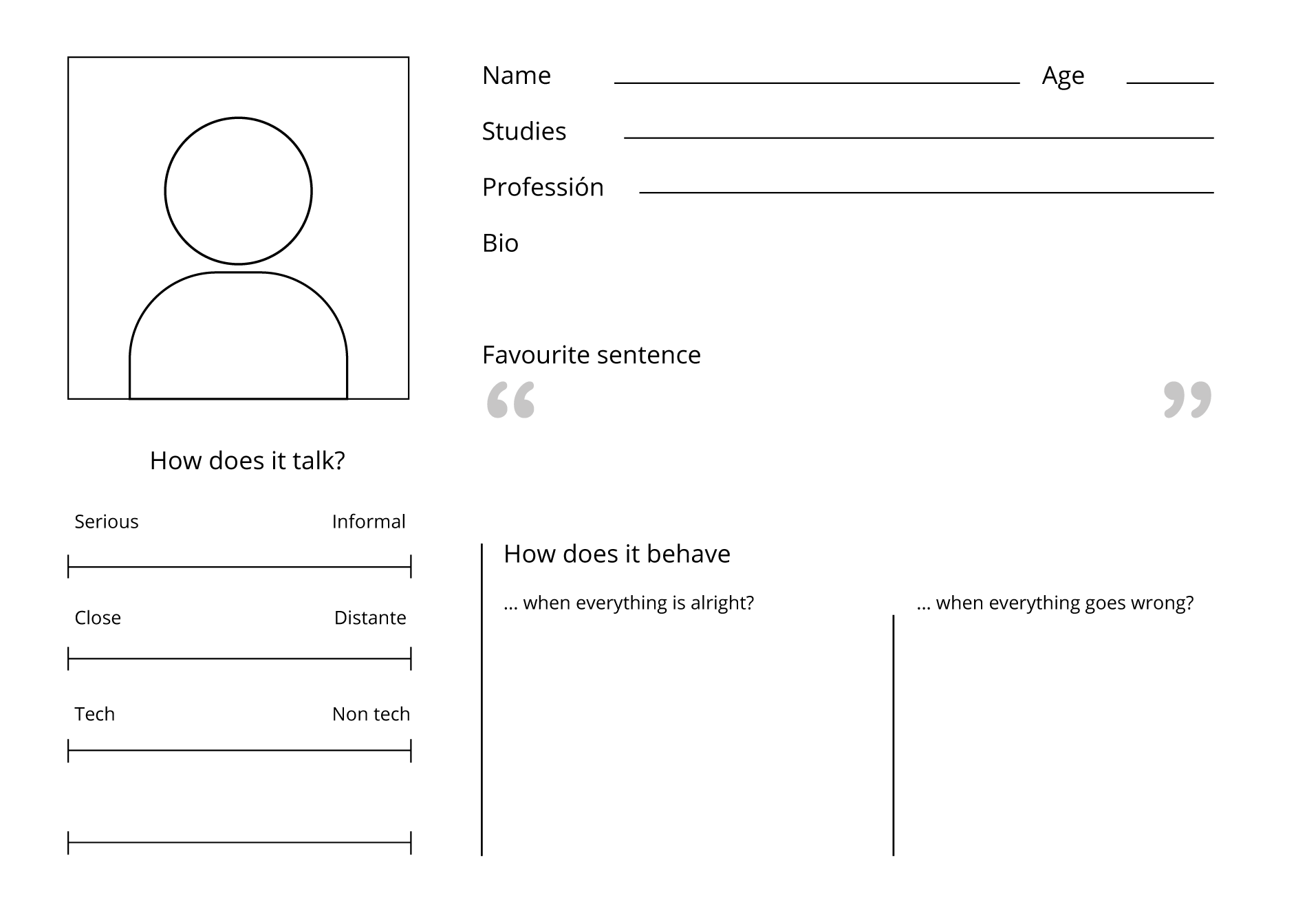
Interaction Elements
Words. That’s it… nope!
There are already some great articles talking about the interaction elements we have nowadays (this one with seals is my favourite one).
We could also make a timeline about the evolution and adoption of the different interaction elements, but the conclusion would be the same. The trend is to avoid any conversational interaction, replacing it with all sort of complex interactions, and transforming the old chat into something like an embedded web page.
Here you have an interesting article explaining how Google paved the way some time ago: How Google’s AI paved the way for the next generation of bots.
We have experienced real conversations bringing headaches and malfunction problems. This can be avoided by offering the users buttons and links to click on. Artificial intelligence and NLP are able to do amazing magic, but they don’t meet user expectations yet. You can read more about it here.
Every platform has different elements, and they change all the time, so you better update your knowledge before starting a project.
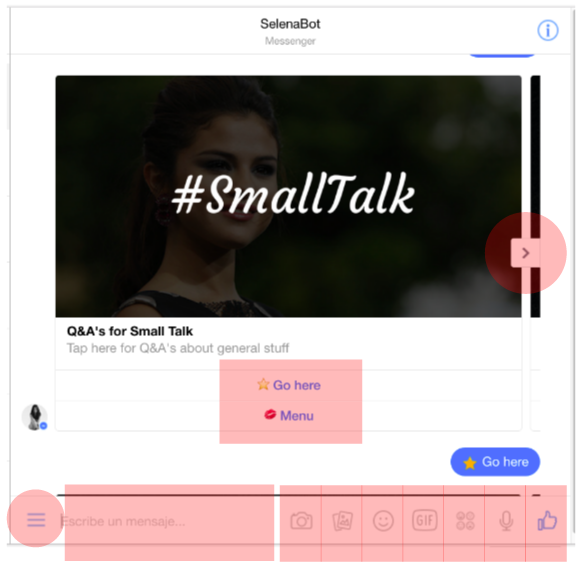
Information Architecture
Even in a chat we need to decide which information will be offered first and which information we are hiding. We can understand the chatbot flow like a screen flow with little information in every step, and different interaction elements on each part, where some actionable “buttons” are just words users can type.
Because of that I treat the information architecture as in any other interface by defining which interaction elements I will show on every step.
Navigation Flow
We need to design the navigation map for our chatbot in which we’ll define what will happen in every single step.
We should be thinking about every possible scenario on every step: which interaction element the user will be using, what will happen if they misunderstand any step like “What if they want to go backwards,” “What about skipping steps?” etc.
You can find more about how I do it on my Design framework for chatbots.

Prototyping Tools for Non-Developers
The same way we can find interface design tools, chatbots tools are beginning to spread. I differentiate them in two groups: low fidelity and high fidelity.
In the first group, there are tools that help us explain our chatbots and in a short time, we can get great results and be ready for testing much more quickly. There are a bunch of these, but my chosen ones are:
- https://botsociety.io: Allows you to export the designed conversation on a video. They are adding more functionalities in order to allow more complex conversations and even different flows on a conversation. They are probably the leaders right now in this area.
- https://botframe.com: you can generate a quite customizable conversation that you can export to png.
For high fidelity tools, we end up developing a real chatbot without writing a single line of code, but obviously with limited functional complexity. About them I would recommend:
- https://octaneai.com: the position they are reaching in less than one year is something to be admired. I like their proposition about convos and the poll functionality.
- https://chatfuel.com: it’s probably the rival to beat, but they haven’t changed very much in the last few months and their competitors have. They offer chatbots for Facebook Messenger and Telegram.
- https://rundexter.com: It was the first tool I discovered even when they weren’t focused 100% on chatbots, but they remain quite aside, and they seem to be oriented to developers.
Analytics Tools
There are already a few players willing to become the Google Analytics for chatbots. Here are some of them, plus some other tricks that will help you understand what’s going on with your chatbot:
- http://botanalytics.co: They offer a lot, but the results they give are still quite far from expected.
- https://www.dashbot.io: The best one we have tested, but I still have some information missing… Besides the figures they offer I’d love to have information related to my chatbot performance and specially about funnels and how users are leaving them.
- In-app solutions. Some of the chatbot platforms are already offering some data, like chatfuel and octaneai itself.
- Direct access to Facebook Messenger conversations. Every chatbot on Messenger is associated to a Facebook page which means you can review the automatic conversation at any time, and even take part on it. Basically you can read every single thing a user says to your chatbot. Remember that the next time you say any bad word to an assistant.
Conclusion
Chatbots are one of the buzzwords nowadays, and they may eventually replace most of the interfaces we are used to. It will take time, and maybe the definitive chatbots and virtual assistants won’t look like those we have today. Don’t worry though, as a UX designer you are already a master of most of the things you need to work on its design.
7 Things You Know in UX That Will Help You Design Chatbots was originally published in Chatbots Magazine on Medium, where people are continuing the conversation by highlighting and responding to this story.
Internet craque complètement pour ce Shiba peintre
Il y a des chiens de chasse, des chiens de sauvetage, des chiens policiers, des chiens de traîneaux, des chiens de concours, des chiens qui font des tours, des chiens qui ne font rien du tout. Il y a maintenant un chien peintre : il s'appelle Hunter et vient de Edmonton en Alberta, Canada. Alors que votre chien ne sert qu'à vous lécher le visage et à vous coûter un max de fric, Hunter se spécialise dans l'expressionnisme et rapporte du blé à ses maîtres en vendant ses toiles sur Etsy.
Ses maîtres s'appellent Kenny et Denise, sont respectivement ingénieur informaticien et professeure. Ensemble, ils ont patiemment appris à Hunter à se servir d'un pinceau, d'une palette et d'un châssis pour qu'il puisse exprimer ses doutes, ses joies et son mal-être de chien japonais déraciné.

Gold Coast
« Comme tous les chiens, il aime faire des tricks, surtout si ça lui rapporte une friandise. Mais avec lui, cela va plus loin. Quand il apprend quelque chose de nouveau, on voit vraiment qu'il est fier de lui. Ce n'est pas juste la bouffe qui le motive. On sent bien qu'il aime apprendre et découvrir de nouvelles choses, même si au début il n'y arrive pas. Je pense que c'est quelque chose que partagent la plupart des artistes et la plupart des chiens. »

Midnight Reverie
Inutile de vous dire que la carrière de Hunter fait un carton… essentiellement en ligne pour le moment, aucune galerie ne s'étant encore proposée.
« On ne pense pas qu'il est particulièrement doué, pas plus que d'autres chiens ou espèces. On a déjà vu des chiens faire des choses que Hunter ne pourrait vraiment pas réaliser. Comme avec les humains, cela dépend vraiment de la personnalité et de ses goûts. Et puis, il faut être patient et vraiment s'investir dans la passion de son chien. Il faut les encourager sans cesse à repousser leurs limites ».

Selfie
Arrêtez tout, on vient d’inventer le scotch pour LEGO
Sur IndieGoGo, l’entreprise Nimuno commercialise le premier adhésif de l’histoire compatible avec les briques LEGO et plein d’autres pièces de jeux de construction. L’idée est grandiose ! Les briques se fixent sur le scotch de génie, qu’on peut couper, tordre, plier, coller, décoller et recoller partout. Murs, angles, meubles, vitres… n’importe quelle surface devient un véritable terrain de jeu.

un véritable terrain de jeu
A l’origine du projet: Anine Kirsten et Max Basler, deux designers industriels du Cap en Afrique du Sud. Trois jours seulement après le lancement de son financement participatif sur IndieGoGo, Nimuno a déjà rempli ses objectifs avec quasi 12 000$ récoltés sur les 8 000$ demandés. Il reste un mois avant la fin de l’opération et l’entreprise annonce déjà développer de nouvelles couleurs. Comptez 8$ par rouleau de ruban adhésif, pour une sortie prévue en juillet 2017 
Par Margaux Couturier.
HTC Announces Vive Ecosystem Conference
HTC might not have a big western developers conference like Oculus does with Connect, but it’s planning a big show for China in just over a weeks’ time.
The Vive Ecosystem Conference 2017 is set to take place from March 27th – 28th in Shenzhen, China. HTC has told UploadVR that it’s planning some new announcements for the show, though we don’t have any specifics just yet. A keynote speech is set to take place on the first date of the show at 9:00 AM GMT+8 where, according to a rough translation of an invitation, the company will “announce new strategic cooperation and the latest initiatives to build the global VR ecosystem.”
Exactly what that means is up for speculation, but HTC is no stranger to strategic alliances in China and the rest of the world; it setup the VR Venture Capital Alliance (VRVCA) to bring together investors to fund VR startups and is working closely with others to establish VR within China. On the ecosystem side, it’s quite possible that we get an update on the new Vive Tracker add-on, which is rolling out to selected developers now and will be on sale soon. Don’t expect big new Vive games and experience to be revealed, then, but there could be some interesting announcements.
The second day of the event looks to be a more educational experience with seminars about the best practices for VR. There will be an experience area too where we’d expect attendees will get hands-on with the latest Vive demos.
We’ve reached out to HTC for more info about the event. We’re not sure if there will be a livestream though, if there is, it’s likely to all be in Chinese. Still, those that like to keep a close eye on the Vive ecosystem will want to pay attention to any news coming out of the event here.
Tagged with: htc vive, Vive Ecosystem Conference
Worldwide VR / AR headset market to hit 100 million devices
Your weekly guide to Virtuality — Newsletter #57
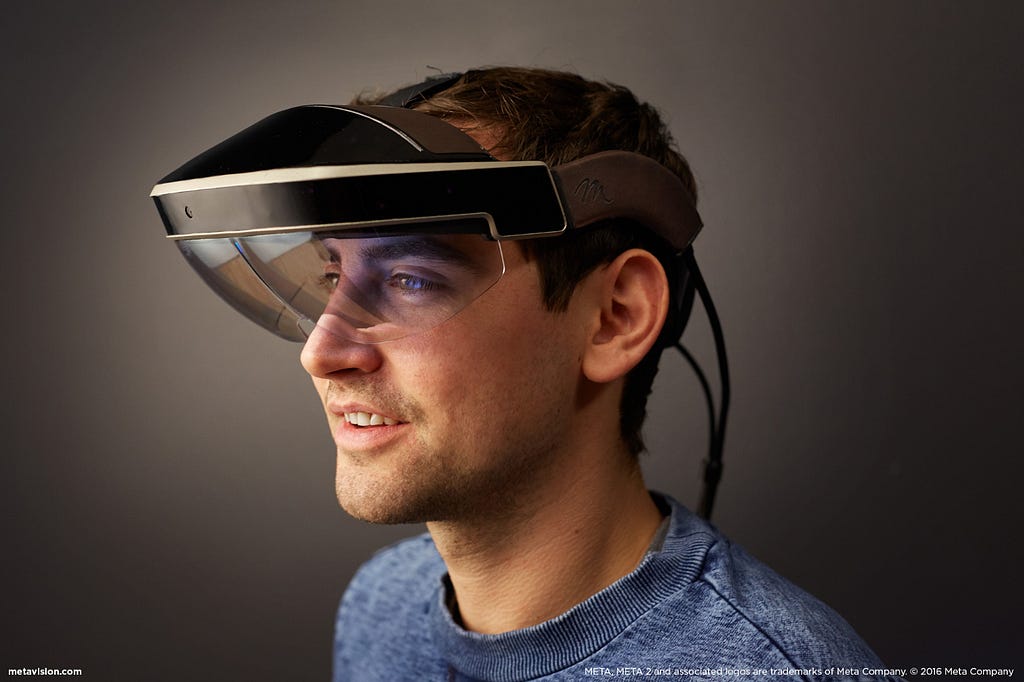
Although augmented reality (AR) remains as the minority portion of the market in terms of shipments, International Data Corporation (IDC) expects AR to bring in significantly more revenue over the course. AR headset sales will grow from $209 million in 2016 to $48.7 billion in 2021. Meanwhile, VR headsets grow from $2.1 billion in 2016 to $18.6 billion in 2021. Both markets are expected to grow at a compound annual rate of 58%, reaching 99.4 million units in 2021… (Read more on IDC Blog)
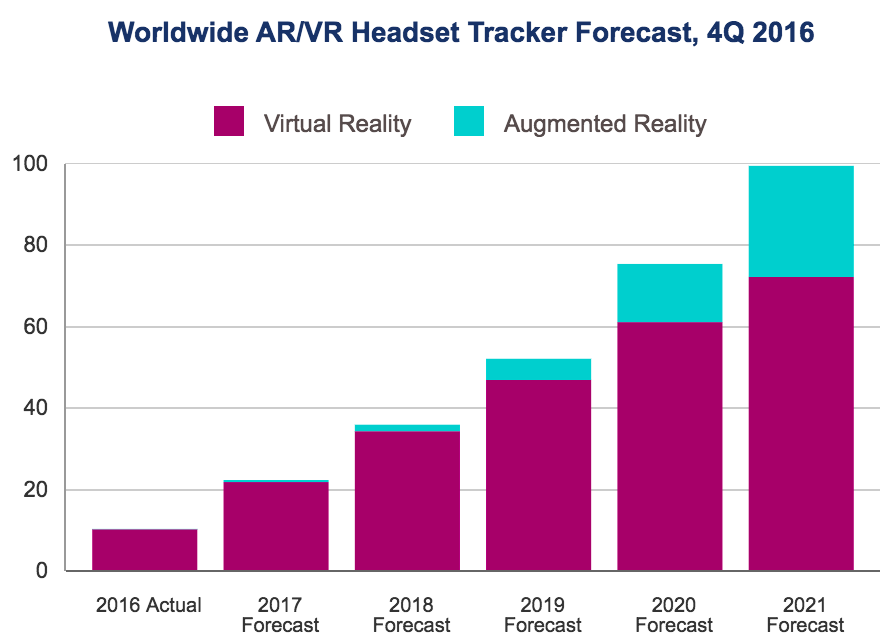
This is Haptical weekly newsletter #57. We bring you an in-depth look at the latest Virtual, Augmented and Mixed Reality technologies, services & products.
A very special thanks to John Buckley, Joseph Elichaa, Lisa Winter and others for starting a membership with Haptical.
If you want to get a deeper understanding of the state of virtual reality, you can sign up to our exclusive reports today. Go to bit.ly/joinhaptical and become a member now!
LATEST NEWS
- Troubled GoPro deepens layoffs, eliminating positions in media and virtual reality divisions. (Forbes)
- Skydance, Sony Pictures debut their first virtual reality titles. (Hollywood Reporter)
- NVIDIA pushes virtual reality play with new benchmarking tool, FCAT VR (ONMSFT)
- The imaging technology startup Avegant says its light field prototype provides a truly immersive experience that is critical for the future success of the entire mixed reality industry. (Seeker)
- Berkeley University opens a new lab for virtual and augmented reality. The lab will be open for faculty members, graduate and undergraduate students. (Haptical)
NEW EXPERIENCES

- Volkswagen takes virtual route to develop the car of the future. (Auto Car Pro)
- Students are developing a virtual reality game based on James Joyce’s “Ulysses” as part of a class at Boston College. (New York Post)
- Airlines Technology has worked up a proof of concept which could allow airlines to sell assigned seats via a virtual reality (VR) seat map. (Tnooz)
- Accenture creates Mixed Reality experience in partnership with RBS 6 Nations. (Sport Techie)
- Civil Air Patrol uses virtual reality to spark interest in aviation. (Chicago Tribune)
INVESTMENT

- Augmented reality company WayRay has raised $18 million in a Series B round led by China’s Alibaba Group.
WHAT PEOPLE SAY ABOUT VIRTUALITY
- This year, for the first time in its 31-year history, SXSW organizers created a “Virtual Cinema,” where VR/AR content creators could show off their best stuff. USA Today’s Rick Jervis headed up to the fourth floor of the JW Marriott in Austin to check out the cinema and see where the technology stands. (USA Today)
- StoryUP’s Chief Storyteller Sarah Hill says VR non-fiction storytelling could influence anti-anxiety states. (Haptical)
- Matthew Busel says, 2018 will be the year most of the country becomes truly familiar with AR (Haptical)
DON’T MISS!

- Listen to these podcasts to dive into virtual reality. We curated some great episodes with our friends at RadioPublic. (Haptical)
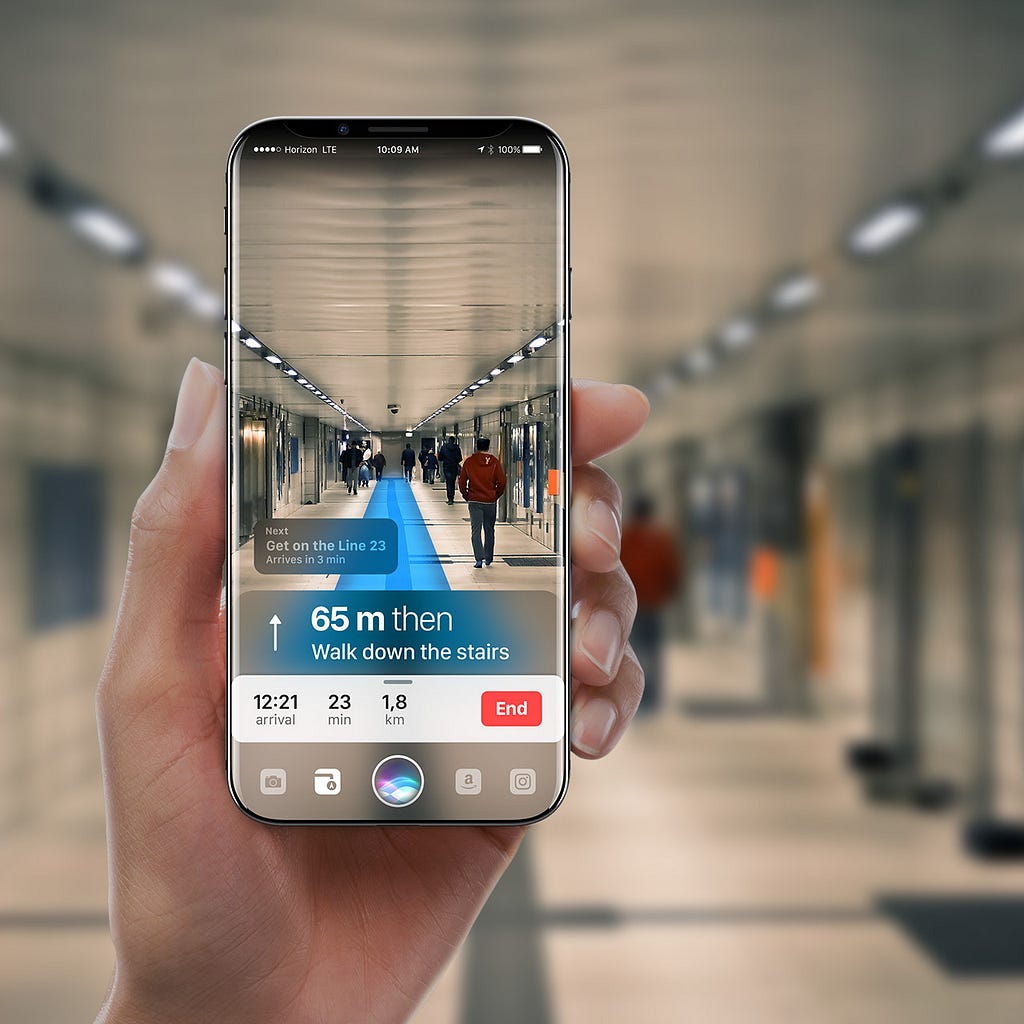
- A new concept design visualizes fully glass iPhone that integrates Siri with augmented reality features. (Haptical)
Follow us on Medium to get the latest Virtual Reality trends and news in your inbox every week.
Sign up to our exclusive reports today. Discover how virtual reality changes everything you knew about education, entertainment, health care and marketing.
Worldwide VR / AR headset market to hit 100 million devices was originally published in Haptical on Medium, where people are continuing the conversation by highlighting and responding to this story.
Weta Workshop’s Ghost in the Shell Major Skeleton is a Masterpiece [Video]
Adam Savage gets up close with the one-of-a-kind 3D-printed endoskeleton Weta Workshop made for the upcoming Ghost in the Shell. Chatting with Weta Workshop technician Jared Haley in the studio’s 3D modeling room, Adam learns about the experimentation and prototyping necessary to make this gobsmackingly beautiful prop, which is made of several hundred individual pieces!
[Tested]
The post Weta Workshop’s Ghost in the Shell Major Skeleton is a Masterpiece [Video] appeared first on Geeks are Sexy Technology News.
Google Home débarque en Europe au printemps

Samsung imagine un abribus qui surprend les passants et discute avec eux
En Israël, Samsung détourne un abribus pour communiquer sur sa montre connectée, qui se met à discuter avec les passants.
Les panneaux publicitaires sont partout dans la rue. On est tellement habitués à les voir, que parfois, on n’y prête même plus attention. C’est sur ce fait que Samsung a voulu jouer pour sa nouvelle campagne publicitaire mise en place en Israël avec l’agence Leo Burnett.
À Tel Aviv, la marque a eu l’idée de détourner un abribus en cachant à l’intérieur un vrai complice. Alors que les passants attendent le bus, le passant se met à interagir et à discuter avec eux. Une promotion surprenante et amusante imaginée par Samsung pour faire la promotion de sa montre connectée Galaxy S3 Frontier. Bien vu !





Source Samsung & Leo Burnett Israel
Via adsoftheworld.com
Cet article Samsung imagine un abribus qui surprend les passants et discute avec eux provient du blog Creapills, le média référence des idées créatives et de l'innovation marketing.
Scene Fusion Brings Multi-User Development To Unity’s Editor VR
Back at GDC 2017 at the start of this month Unity gave us a brief update on Editor VR, its new platform for developing 3D content within headsets like the Oculus Rift and HTC Vive. The company showcased some of the new tools that were supporting the platform, including Scene Fusion from KinematicSoup Technologies
This week, KinematicSoup is announcing official integration with Editor VR as part of the platform’s latest update. That means any of the 6,000 plus people that have already downloaded the software in its alpha state can access this new tool, which lets multiple people collaborate in real-time in multiple ways. Think of it like multiplayer VR as you’re actually making your game; using position tracked controls users can intuitively build a scene together.
This has a ton of potential for optimising VR development, and you can see why in the trailer above, released in January. Not only can two people enter VR together to edit scenes with each other, but one person could go into VR while the other works on the game from the traditional screen. The studio describes this as the out of VR developer doing ‘Big Picture work’ while the in-VR developer does ‘detail work’ and provides feedback.
KinematicSoup says the app could make VR development much more efficient and speedier. What really captures out attention, though, is the possibilities Scene Fusion could have when combined with other Editor VR Tools like Tvori, allowing people to collaborate not just with object placement but other creative aspects.
Scene Fusion is available as a premium non-VR plug-in for Unity too, but Editor VR hasn’t really been established as a monetizable platform yet, so it’s unclear when or how Tools developers will make money.
In fact there’s still a lot to learn about Editor VR as a whole, but Tools such as these suggest Unity is well on its way to making the accessible development platform it envisions for the future, whether people are making VR or non-VR content.
Tagged with: Editor VR, KinematicSoup, Scene Fusion, unity
Hayo’s Kinect-like sensor for your home now has an API
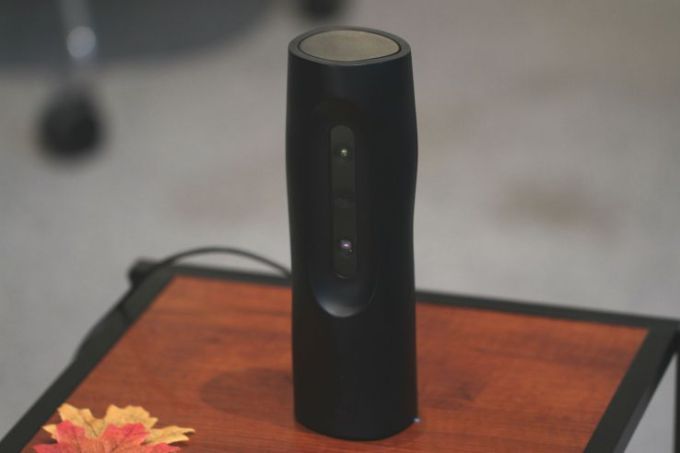 Sometimes I miss the Kinect. It was such a breakthrough device, yet it didn’t go anywhere. But it inspired a lot of entrepreneurs, including the team behind Hayo. This new device lets you set up virtual buttons on a table to control all your connected objects. Hayo recently announced there will be an API so developers can play with the company’s image recognition technology. Read More
Sometimes I miss the Kinect. It was such a breakthrough device, yet it didn’t go anywhere. But it inspired a lot of entrepreneurs, including the team behind Hayo. This new device lets you set up virtual buttons on a table to control all your connected objects. Hayo recently announced there will be an API so developers can play with the company’s image recognition technology. Read MoreWhat Happens If You Throw a Magnet In Copper Pipe [Video]
Most of you probably have already seen videos of similar experiments, but this is so cool that I just had to share it with you guys.
The post What Happens If You Throw a Magnet In Copper Pipe [Video] appeared first on Geeks are Sexy Technology News.
Wizards of the Coast is releasing an official app to support your D&D campaign

Stacks of papers are a staple at any regular Dungeons & Dragons game, but Wizards of the Coast is finally offering a digital client to help gamers manage their characters. Today at PAX East, the company revealed a new “Digital Toolset” that works with Fifth Edition called D&D Beyond.
Billed as a game management tool, D&D Beyond has an official rules compendium, a character builder and character sheet. From the looks of it, it’s designed to make it easier for players to look up rules and update their characters as they play.
The company partnered with Curse, a media company owned by Twitch that builds gaming management tools for a range of platforms. D&D Beyond appears to be a client designed to bring the traditional pen-and-paper...
7 Things We Can’t Wait To Stick The Vive Tracker On
I sort of see the new Vive Trackers as like the post-it notes of VR, in that I want to stick them to absolutely everything. I often walk down the street looking at things you could virtualize by clamping HTC’s new peripheral to them. In fact I probably scare people when they see me contemplating a trash can and talking to myself about what it could do for VR.
Okay, that doesn’t really happen, but the Vive Tracker does open up a new world of possibilities for SteamVR. The kit, which is essentially a piece of plastic that your base stations will track the position of just like they do your headset and controllers, is already shipping out to developers, and we’ve seen a handful of ideas from the community.
But we’ve had a few ideas of our own. Here’s what we’d like to stick the Vive Tracker to when it starts to roll out later this year.
Instruments
When you think about it, Oculus and Harmonix thought up the basic concept of the Vive Tracker a long time ago, when it stuck a Touch to a plastic guitar and gave us Rock Band VR. We’ll find out how they worked out for the pair in a few weeks, but the Tracker could actually bring our real instruments into VR so that we could play them in front of scores of adoring virtual fans. There’s a lot of potential for a Rocksmith-style VR tutoring game here.
Cups
We all know playing VR games can be physically demanding — my shoulders still hurt from my latest round of Paulo’s Wing — so it’s a pretty good idea to stay hydrated throughout. Removing your headset and finding your icy beverage is annoying; why not just have it in the virtual world too? Note that this won’t solve VR’s awkward angles issue where most cups won’t actually be able to tip into your mouth without hitting the bottom of your headset. Forget positional tracking; tell John Carmack this is where the real innovation is needed.
Phones And Tablets
I’ve already seen a pretty cool multiplayer VR game that stuck a Vive Tracker to a phone, but I’m talking about bringing those devices into the virtual world with the user. Smart devices could be incredibly versatile input mechanisms for specific VR experiences. Imagine what it could do for exisiting experiences like Tilt Brush, allowing you to fine tune your creations with greater depth. Plus it would be great to quickly flick through your phone in VR.
Toy Lightsabers
Since 1977 humans have dreamed of what it would feel like to hold a real lightsaber and do glorious battle with evil forces. We came pretty darn close in 2016 with Star Wars: Trials on Tatooine but we could come even closer with the Vive Tracker stuck to a plastic sword. Imagine two of these things in the hands of two friends having what felt like a real lightsaber battle with tactile feedback. Okay, better make them out of foam instead. No headshots, either.
Friends
We’ve already used the Vive Trackers to bring our own bodies into VR experiences, but what if we put them on our friends? What types of experiences might be possible? Imagine the kinds of co-op games you could make in which friends could work with you and have a real presence in the virtual world. Again, you’re probably dealing with a lot of health and safety concerns, but this is definitely something that games like Keep Talking And Nobody Explodes should consider for future updates.
Pets
Some readers with a friendly cat or dog will probably be familiar with the stomach-churning guilt that comes with accidentally kicking them while walking around in VR. It’s all too easy to forget that a four-legged creature might be trotting up to say hello while you’re jumping around in your living room. I would happily pay $100 not to have that experience again and attach a VR life jacket to my pets. This might also be good for babies.
Oculus Rifts
The Tracker might not be the perfect answer but it’s certainly one possible way of achieving a larger room-scale setup for your Rift. As Valve’s tracking hardware continues to evolve it would be great to give Rift owners the option to buy some base stations and a few trackers to get larger room-scale tracking on their headsets.
Tagged with: htc, htc vive, Vive Trackers
Blockchain Will Change Far More Than How Your Money Is Managed
Organizational Upgrade
The times they are a changin’. Spurred by technological innovation, our world is hurtling forward at unprecedented speeds and it is altering how we work, play, and live. However, our organizations, institutions, and governments have not been able to keep up with the pace of change. Too many of them were built on outdated systems that never could have predicted the impact things like the computer or the internet would have. Thankfully our methods for organizing ourselves are themselves finally evolving and nothing has been a bigger breakthrough in that regard than blockchain technologies which have the ability to fundamentally change how we organize ourselves.

What is revolutionary about blockchain is that it enables a distributed check on power. Today our systems still rely on centralized authority where trust is given to a select few. What blockchain enables us to do is replace these systems with ones that have no need for a central authority.
The key to the blockchain is that everything on it is monitored by everything else on it. Using bitcoin as an example, whenever a bitcoin gets exchanged, that transaction gets checked against every other transaction in the system to make sure it is authentic and then gets tied to the history of that bitcoin. The entire history of each bitcoin is stored in an open ledger making every transaction traceable.
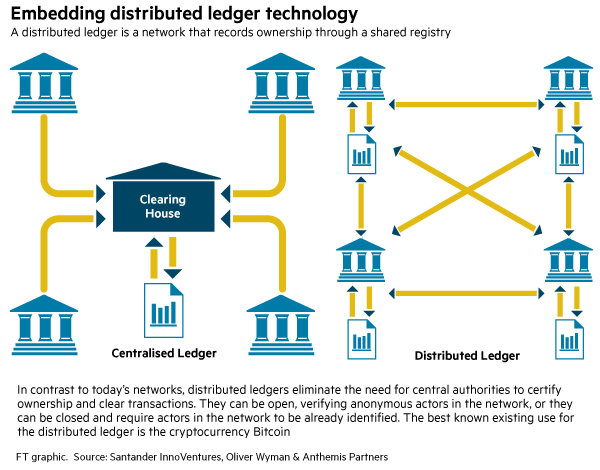
But the real beauty of a blockchain is that it enables people to have absolute trust in whatever it is powering. Trust is the foundation of all institutions, they must earn the trust of its participants and then continue to prove themselves trustworthy in order for people to keep using them. This is why we exchange goods and services for money, we have faith that the currency we traded for will hold its value. Credit, without which no economy can function, is itself defined as “the ability of a customer to obtain goods or services before payment, based on the TRUST that payment will be made in the future.”
What the blockchain enables us to do is to never have to make those leaps of faith. The systems powered by blockchains are inherently trustworthy because there is no wiggle room in the system for corruption, fraud or even human error to play a part as everything is distributed, verifiable and open to anybody using the system. For more on how it works click here.
It is hard to understate the kind of impact that this can have. As stated in the book Blockchain Revolution, “some scholars have argued that the invention of double-entry book-keeping enabled the rise of capitalism and the nation-state. This new digital ledger of economic transactions can be programmed to record virtually everything of value and importance to humankind…In fact, soon billions of smart things in the physical world will be sensing, responding, communicating, buying their own electricity and sharing important data, doing everything from protecting our environment to managing our health. This Internet of Everything needs a Ledger of Everything. Business, commerce, and the economy need a Digital Reckoning.”
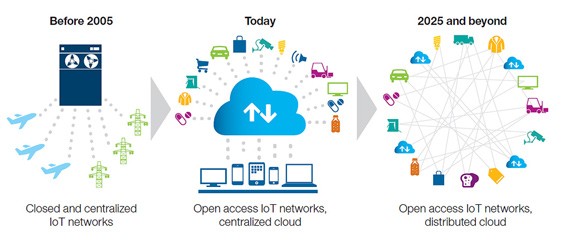
More Than Money
Not only are a host of financial services now using blockchain technologies, but it is also being used to write smart contracts, secure our digital identities, and even to back marriage. IBM is a leading player in blockchain technologies and recently launched a blockchain powered tool for government organizations to help them gain more trust from their citizens. The technology is spreading rapidly as more and more companies are seeing its merits.

But its real potential is the role it could play in reshaping our political systems. The technology allows for direct democracy where every citizen could vote on issues themselves rather than just electing representatives to decide on issues for us. In addition, if national currencies began using blockchain backed systems then each citizen would be able to track exactly how each of their tax dollars gets spent. It has within it the promise of a world that is incorruptible, completely transparent and one in which anybody who wants to participate can have equal say in how society chooses to order itself.
The technology that enables the blockchain has only been around for 9 years, and like all good ideas, it will take time before its potential is realized. But it does seem to be one of those ideas that has staying power as it holds within it the ability to change how we organize the world we live in.
The post Blockchain Will Change Far More Than How Your Money Is Managed appeared first on Futurism.
How to Design the Best UI for Room-Scale VR
As virtual reality becomes more and more mainstream, we, the designers and developers, are starting to build in bullet-proof techniques and…
Microsoft just released a fully functional, Terminator-style HUD for HoloLens
Microsoft posted a tutorial on creating a Terminator T-800 heads-up display using HoloLens and Unity, complete with face detection and optical character-recognition capabilities.
The post Microsoft just released a fully functional, Terminator-style HUD for HoloLens appeared first on Digital Trends.
DeepCoder, l’IA capable de coder des programmes simples à la place d’un développeur

Des chercheurs de Microsoft et de l’université de Cambridge ont créé une IA qui peut coder sans intervention humaine des programmes en combinant des lignes de code récupérées sur des logiciels existants : un pas vers une automatisation du travail des développeurs ?
Microsoft et l’Université de Cambridge ont développé une intelligence artificielle nommée DeepCoder qui utilise des techniques d’apprentissage automatique (machine learning) pour coder des logiciels simples, en combinant des lignes de code trouvées sur des logiciels existants. L’IA vérifie que les combinaisons de lignes de code qu’elle propose sont fonctionnelles, et au fur et à mesure qu’elle créé des combinaisons fonctionnelles, elle peut coder des plate-formes de plus en plus complexes.
Actuellement DeepCoder est capable de produire des programmes opérationnels utilisant jusqu’à 5 lignes de code : cela peut sembler peu, mais 5 lignes permettent déjà d’élaborer des fonctionnalités relativement complexes.
Création de combinaisons de code originales
Un intelligence artificielle de ce type présente l’avantage, sur un développeur humain, de travailler plus rapidement, de synthétiser une masse de données plus importantes – et donc de trouver des combinaisons de code auxquelles un développeur n’aurait pas forcément pensé. En s’améliorant, elle permettra d’automatiser le travail le plus rébarbatif des développeurs.
L’objectif officiel n’est évidemment pas que les codeurs humains soient remplacés, mais qu’ils puissent se dégager des tâches que les IA peuvent accomplir à leur place, et ainsi avoir plus de temps à consacrer à la partie la plus complexe de leur travail.
Un risque pour les développeurs d’être (partiellement) remplacés ?
Cela étant, Marc Brockschmidt, l’un des créateurs de DeepCoder, affirme que les futures versions de son IA pourront développer des logiciels capables de récolter des données sur les sites web ou de catégoriser des photos sur les réseaux sociaux : dans ce cas, aucune intervention humaine ne serait nécessaire.
"DeepCoder, l’IA capable de coder des programmes simples à la place d’un développeur" by Rude Baguette originally appeared on Rude Baguette
Room Scale MMO OrbusVR Has Been Funded On Kickstarter
As the software ecosystem grows, developers are starting to find a balance that allows them to create solid multiplayer experiences on VR platforms. The community is welcoming massive amounts of VR players, but the MMO (Massively Multiplayer Online) genre hasn’t really found a solid foothold just yet. Enter OrbusVR, the Kickstarter project looking to bring room scale combat, exploration, and crafting in VR MMO format.
You can see the trailer for it below, featuring a simple visual style and action-packed gameplay.
At the time this article was written, OrbusVR has accrued a funding amount of $23,997 on a goal of $10,000. Though this may seem meager by the standards set by other well known successful games funded on the crowd-funding platform, OrbusVR is no less ambitious with its plans. The gameplay teaser shows huge groups of players fighting in fields utilizing medieval fantasy weapons, exploring caves, teaming up against large boss characters, and even some fishing— the minigame that absolutely no MMO should ever go without.
“The support of this game by the growing community of VR enthusiasts continues to surpass our expectations at every turn,” says lead programmer Riley Dutton in a press release for the project. Dutton is also the Founder of Ad Alternum, the dev team making the game.
The game is adopting a low poly style that could be endearing to fans or a turn-off but, considering it was fully funded plus some, there are clearly fans interested in the project. The game is also not just in conceptual stages. The footage in the trailer is collected from 3 play tests in which 1500 players have played and things look to be quite functional from what we see.
“Our Stretch Goals represent things that we want to do in the game eventually, but didn’t have the resources to commit to doing before launch,” said Robert Dutton, Level Designer. “We’ve intentionally kept the scope of the project reasonable so we can meet our deadlines, but with the extra help from the community, we can do more than we originally planned, which is great.”
OrbusVR is slated to be released on HTC Vive and Oculus Rift. The Kickstarter is ongoing until March 13th and, while early bird funding bundles are taken, there are still many contributor awards available such as closed Beta and closed Alpha access.
Facebook Messenger Platform v1.4

Today, Facebook announces Messenger Platform v1.4.
Since Facebook gave a great vision and platform strategy for next 10 year roadmap, a Messenger Platform/ the next main platform which has a backend system with a personalization engine plus Natural Language Processing, Emotional Recognition, Machine Learning, Deep Learning, etc, could be a core system and main platform for developers and a Facebook users.
“How Bots will change the world more??”
We, many Bots makers, Bot Entrepreneurs, Marketing Ninjas, Conversation Flow Designer are trying to catch up, learning each other, making a great Bot for users with awesome Folks collaborating together.
Thanks, guys. However, all of us need to listen up and check closely now.
As everyone is learning its update today, the lists below are the things we need to know at least, otherwise, you will be behind!!
We, the Foxsy team already tested its updates in order to improve our Bot, Foxsy. We could share some insights with you all today.
I hope it’s useful for everyone.
Here, it is very important updates for all of us.
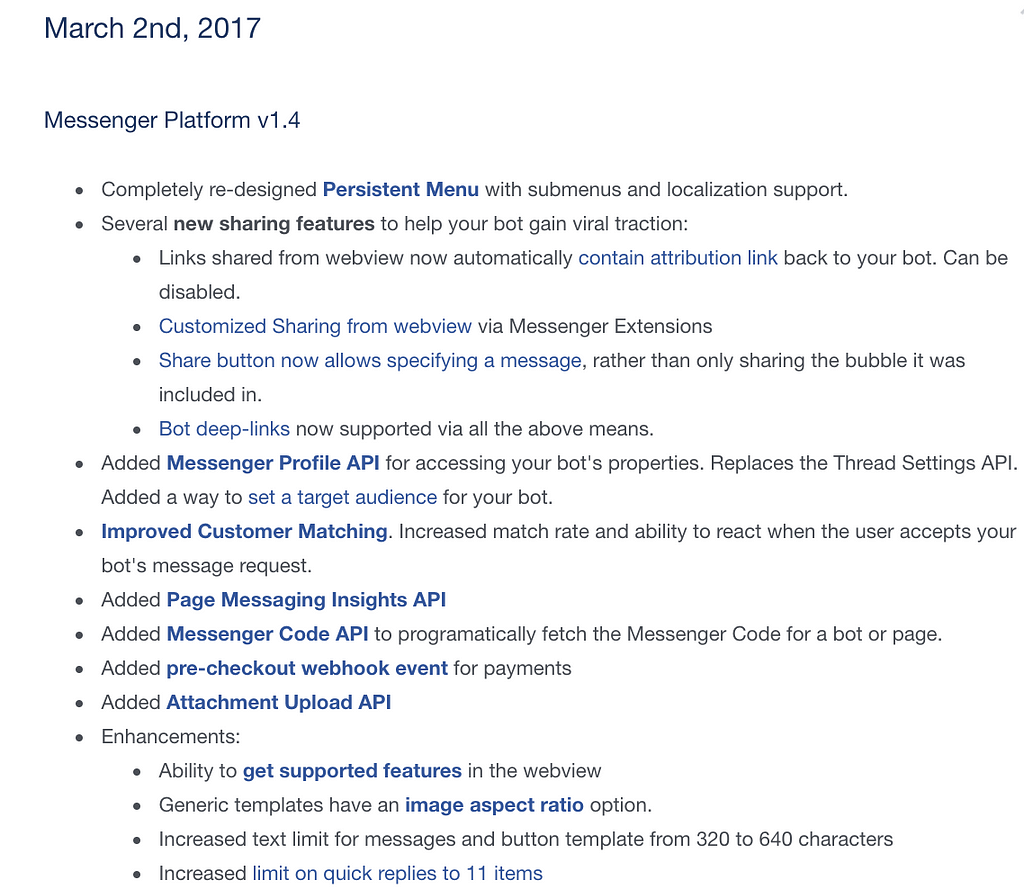
1. Persistent menu (Main menu)

Firstly, the persistent button is moved to the right size from the left side instead of a Facebook legend “Like” Button.
If you click it, the keyboard is popped up from the bottom.
The pic above is an example. Also, the previous keyboard used to have a persistent menu always a left side on the keyboard.
However, it is changed and gone somewhere.

Secondly, there are three layers from a single menu with 5 menus bar.
- Up to 3 levels of submenus
1. Main, 3 menus.
2. Second, 5 menus.
3. Third, 5 menus.
In total, it will be 75 menus like pulldown menus.
Mmmmmm, not sure how to design this to guide users correctly and clearly.
2. Update issues
Even Facebook has a great update today, there are some update issues here. For instance,
Who and when can get upload is based on this information below.
- Developer side implementing new functions
- Accounts (Developer or just users) Time, Mar 2nd
- Mar 20th for all users in public.
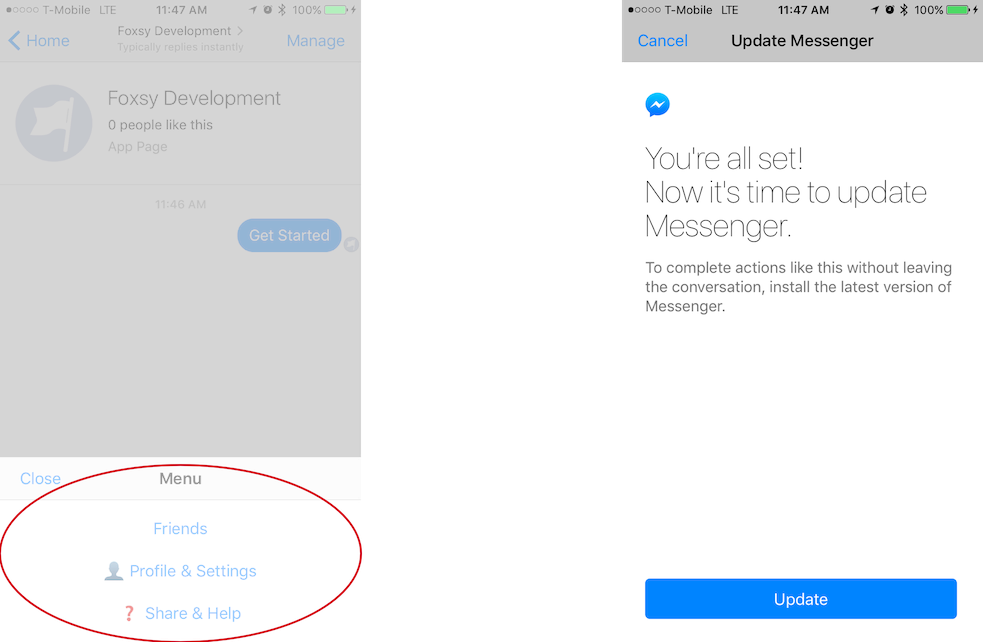
If you are all set,
it means that as we update our Bot or users update their messenger app, we, Bots makers need to concern about these situations. Otherwise, it causes a really bad UX based on a new UI. It’s tough topic for us.
“ Be sure to use Messenger v106 or above to test your bot with the new design. As of March 2nd 2016, all bot developers will see this menu. To allow bot developers time to update, public users will not see the new menu design until March 20th. Your bot’s menus are cached by Messenger but updates are fetched periodically. If you update the menu, you can trigger this fetch by deleting the bot’s thread and then beginning a new one.”
If a user doesn’t have a current version of messenger, even if you created the new version of persistent menu, it shows this menu even though a number of menus are just three. Well, how we could change it better?
3. Pic size
It could bring a better visual information. In our case, a profile pic could be clear and much bigger than now. We might change it in the future.
- horizontal image aspect ratio is 1.91:1
- square image aspect ratio is 1:1

What do you think about it?
However, this size changes cause the different type of problems, such as quick reply is always here and the contents structure will be changed too.

There are a quick reply, the Keyboard, a new persistent menu, and just normal contents.
“Wait!! It is easy or too much information, for sure.”
Well, we are developers. Thus, we need to say to a Facebook developer team, if you don’t like it, please leave and give me comment, all together voice could change and developer to a Facebook team.
Also, we, the Foxsy team is joining FbStart program. So, we could reach out a Facebook team, I think.
4. API access
Now we can access better date to analyze more for user’s behavior.
For instance, this is the type of numbers you could access.

- Daily unique active thread counts.
- Daily unique conversation counts broken down by user feedback actions, including
- messaging turn-ons
- messaging turn-offs
- thread deletions
- report spams
- others
5. Bots Discovery
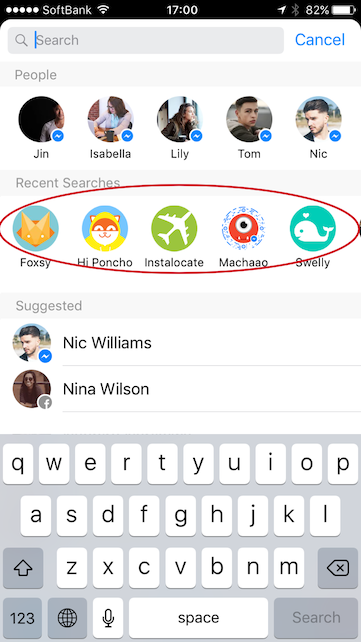
It will be a big change, and that’s we really need it. So far as I used and tested it, it has been just like spamming discovery function too random.
- Localization support (it’s supported now)
In this point, it is like a filter for users to be able to find a proper preferable country based on a Bot, also for developers they can set up their API to get discovered based on countries by users so that they can reach out a specific type of users and segment too.
Even though still it widespread area. For sure, Facebook will bring and make it better so quickly, I wish. I believe you guys, Facebook.
6. Share function
Foxsy has a user’s status and tracking ID to give them a referral. However, it has not been perfect yet. Because this part has issues for two share link and share button to a receiver.
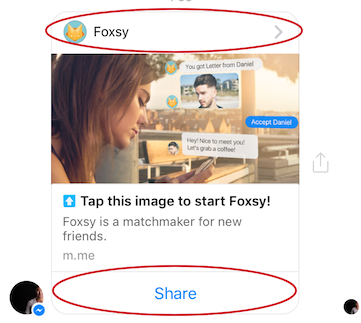
- Able to delete “attribution link” which is the link button on the top of shared messages.
- Able to share from web view
- Able to send different contents from bubbles attached share button.
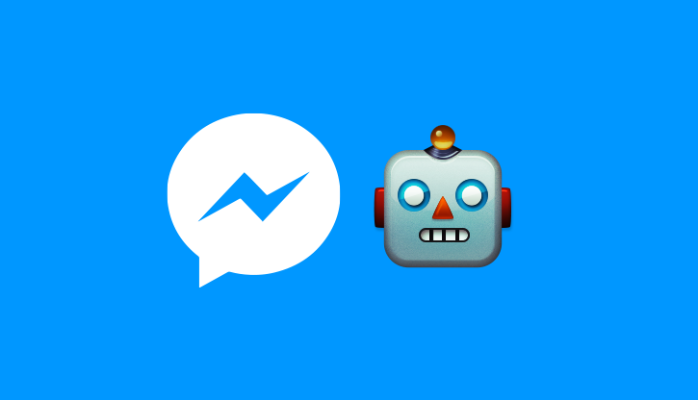
7. NLP or template based on UI?
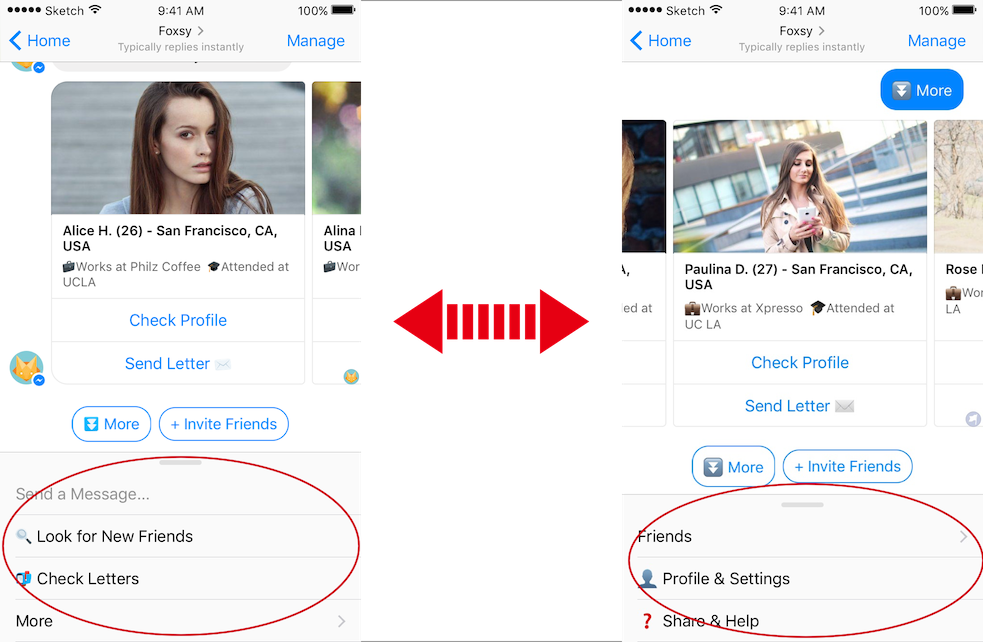
- Ability to turn off freeform input
Also, based on a new update, there may be two types of Bots will be shown up. Once a user updates their messenger, this screen is shown up.
They are ready to use it to discover a new Bot experience.
- Swelly type of Button and template based on UI.


(Swelly)
Swelly is obviously the best and largest number of users and succeeds Bot ever. However, my friend, Peter told me that Swelly team doesn’t focus on developing command and text based on an interaction and a responsive. That’s how they make and develop an easy and user-friendly interface and experiences too.
- Hi Poncho weather Bot.

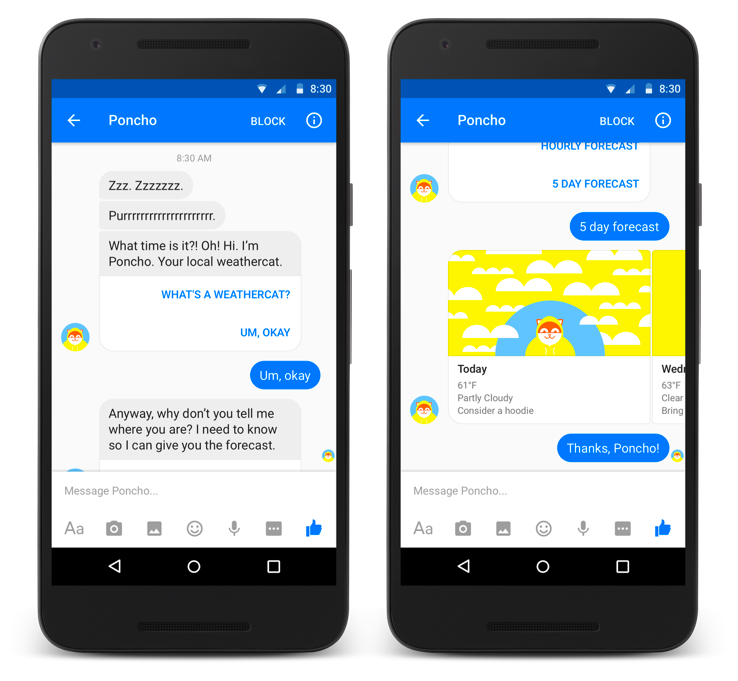
(Poncho)
Poncho is well known friendly weather prediction Bot like a friend.
Based on user’s command, Poncho responds very quickly with a great humor.
- M, run by Facebook.


(M, Facebook)
M, everything is based on a free text. A user can type whatever they want.
Based on rumor and my friend’s experience (coz, I haven’t used it before, that’s shame)
The backend system is the hybrid with the system and human. That’s how they bring a new user experience like feeling talking with a human.
“Make meaningful and beautiful connections in the real world”’




Facebook Messenger Platform v1.4 was originally published in Chatbot’s Life on Medium, where people are continuing the conversation by highlighting and responding to this story.
Microsoft starts shipping mixed reality developer kits
Microsoft’s mixed reality support will also arrive on all versions of the Xbox One








